Jun-01-19
 | | KEG: A final round collapse by Janowski and a nice finish by Halprin. Going into this final round game at Munich 1900, with a record of six wins and five defeats (plus three draws) was already having (for him) a second consecutive disappointing tournament (after his tie for 10th-11th at Paris earlier in the year). Had he managed to win this game against Halprin, he would have finished in 6th place. With a draw, he would have tied for 6th-7th with Cohn. With this loss, Janowski ended up in a 4-way tied for 7th-10th. A second-straight major disappointment for Janowski after his tie for 2nd-4th at London 1899 (with Maroczy and Pillsbury behind only Lasker). Halprin, by contrast, was destined to finish 13th at Munich 1900, whether he won, list, or drew this final round game with Janowski. He had, however, just played the dramatic game of the tournament (his 14-round spectacular draw with Pillsbury ably recounted in the introduction to Munich 1900 by Phony Benoni on this site). Thus, it must be imagined that Janowski was in a wretched mood as he sat down to play this game while Halprin (who probably had not expected to obtain a major prize) was the hero of the hour after having given Schlechter and Maroczy a chance to tie Pillsbury for first. Janowski came out of the opening OK, and even introduced an important innovation (7. Bf4!) in the Queen's Gambit Declined. But beginning on about move 17, Janowski seems to have lost interest in the game, and began making one poor move after another. He may have been lost as early as move 21, and matters went downhill fast for Janowski from there. He shoult probably have resigned by about move 27, but played on in a hopeless position for another 17 moves while Halprin beat the stuffings out of what was left of Janowski's carcass of a position. Janowski was to re-emerge as a force in international chess tournaments in Monte Carlo where he finished first. The present game, however, is (the opening few moves aside) an example of Janowski at his worst. 1. d4 d5
2. Nf3 Bf5

click for larger viewThis move has the important virtue of getting the c8 Black Bishop (which often gets buried after 2...e6) into the game. The downside is that b7 is undefended, a theme Janowski exploited in the opening moves in this encounter. 3. c4 e6
4. Nc3 c6
4...Bb4; 4...Nd6; and 4...Nf6 are all reasonable alternatives. 5. Qb3
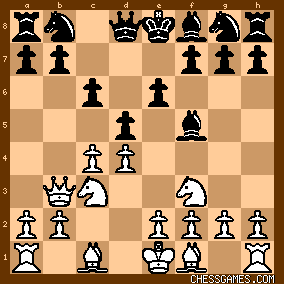
click for larger viewA favorite move of Kramnik and Shirov, that has also been played here by Gulko (at least twice), Ribli, and Khalifman. 5... Qb6
Probably the best response to 5. Qb3.
6. c5
A good move later adopted by the likes of Flohr, Svidler, Shirov, Gulko, Miles, and Kramnik. 6... Qc7
In light of Janowski's next move, this can't be right. Yet it has been played by Larsen, Bronstein, Christianson, Gurevich, Svidler, Shirov (who has played both sides of this variation), Salov, Short, and Gelfand. They must see something here that eludes me. 6...QxQ would give Black nearly even chances, whereas, after the text... 7. Bf4!
"!"--(Tournament Book)
Janowski's innovation, and a good one in my book: 
click for larger viewSadly, Janowski seemed to do a walk-about after this clever move, and quickly relinquished the advantage his fine innovation had given him, and later ruined what was left of his chances in fairly short order. |
|
Jun-01-19
 | | KEG: Post II
7... Qc8
An unhappy choice, but the alternative (7...Qd7) was even less savory. 8. e3
An on-form Janowski might have tried 8. Nh4 to obtain the advantage of the two Bishops (which were usually a lethal weapon in Janowski's hands). The text is not bad, but a sign that Janowski--after his fine 7th move--was playing by rote. 8... Nf6
Halprin could here have neutralized the threat of 9. Nh4 with 8...h6 or 8...Be7. 9. Ne5
"?"--(Tournament Book)
I'm not sure this move deserves a "?", and I don't much like the Tournament Book's proposed 9. h3. The Tournament Book is surely correct that the text was not best (unless Janowski was playing for quick exchanges and a short draw). 9. Nh4 and 9. Be2 were among the better options at Janowski's disposal. 9... Nbd7
The Knight Janowski had precipitously advanced to e5 must now either retreat of be traded off. 10. Be2 NxN
11. BxN Nd7
12. Bg3

click for larger viewJanowski still had some pressure, but most of his advantage was gone at this stage. 12... Be7
13. 0-0 e5
"!"--(Tournament Book)
"A consequence of 9. Ne5" -- (Tournament Book)
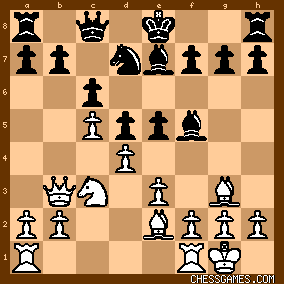
click for larger viewPerhaps as a result of his wild tactical shootout with Pillsbury in the prior round, Halprin seemed to have been rejuvenated (in the nine rounds preceding his 14th round game with Pillsbury, Halprin had four draws and five loses, and in the first 14 rounds had only scored one win). While the text shows admirable fighting spirit, even better was 13...0-0 and then 14...e5. 14. Rac1 exd4
14...0-0 or 14...Bf6 were probably easier roads to equality. 15. exd4 0-0
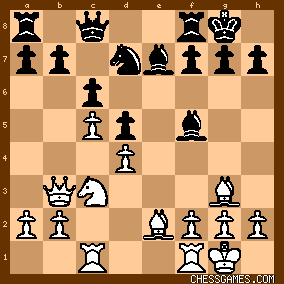
click for larger viewHad I been a spectator, I would have bet on Janowski. While he at best was only slightly better here, it is an open board with four Bishops eyeing the battlefield--exactly the kind of position in which Janowski usually excelled. Meanwhile, Halprin (other than his draw with Pillsbury that was--as Phony Benoni has explained-- in large part thanks to coaching by Maroczy and perhaps Schlechter as well), had lost to all of the "name" players at Munich 1900--Maroczy, Schlehter, Burn, Marco, and Showalter). I would have lost my bet. 16. Nd1
Not a terrible move in theory, but an indication that Janowski was retreating into some kind of mental cocoon. Watch how quickly he turned his decent position into a lost one without Halprin doing a while lot to cause this collapse. 16... Bg6
17. Bf4
A nothing move by Janowski. Having played 16. Nd1, he should have played 17. Ne3. Alternatively, he could have played 17. Re1 first (with 18. Ne3 to follow). Instead, Janowski's Knight continued to sit listlessly on d1 until 28. Nc3?, long after he was already dead lost. Even at this stage (i.e., after 17. Bf4), Janowski--though far from lost--was already well into his downward slide: 
click for larger viewJanowski fans may want to tune out at this point. What followed for Janowski from here was not pleasant. |
|
Jun-01-19
 | | KEG: Post III
Janowski at his best was a fantastic tactician. This makes what followed incomprehensible unless we assume Janowski had list list interest in this tournament. 17... Re8
17...Bf6 immediately was also good.
18. Bd3
Unbelievable. Janowski, the great lover of the two Bishops, here offered a Bishop trade that eased Halprin's cause and reduced Janowski's own attacking chances. 18. Nc3; 18. Re1; or 18. Bf3 were all better. 18... Bf6
19. BxB hxB
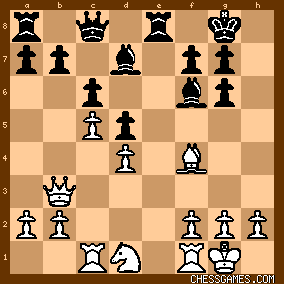
click for larger viewWith Halprin's pressure on his d-pawn, Janowski was already slightly worse. Things soon got truly wretched for him. 20. Qc3
Perhaps the worse way to defend the d-pawn. 20. Be3 and 20. Qd3 were both much better. 20... Nf8

click for larger view21. Be5?
Just awful. 21. Be3 or 21. Qd2 or perhaps 21. Rc2 should allow White to hang down. After the text, Halprin tore Janowski's position to shreds. 21... BxB
22. dxB g5!
"!"--(Tournament Book)

click for larger viewHalprin's move neatly prevented 23. f4. With two weak isolated pawns, Janowski was already in big trouble. He lost no time in making things work. 23. h4?
Janowski needed to play 23. Ne3 or 23. g3 or perhaps 23. Re1. After the text, Halprin easily worked up a King-side attack. 23... Ng6
23...Qg4 was also good.
24. hxg5 Qg4
"!"--(Tournament Book)

click for larger view25. Qd2?
Pathetic. 25. Rc2 or maybe 25. Ne3 might have allowed Janowski to prolong resistance to Halprin's immanent attacking threats. 25... Nf4!
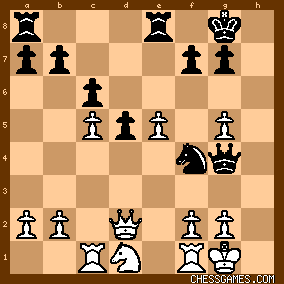
click for larger viewFaced with a threat of mate in 1, Janowski managed to find another lemon: 26. f3?
Other than resignation, Janowski's only plausible option was 26. g3. What followed was brutal. The coming loss of his e-pawn was the least of Janowski's problems now: 26... Qxg5
27. Rc2 Rxe5

click for larger view |
|
Jun-02-19
 | | KEG: Post IV
There was apparently something about Halprin that brought out the worst in Janowski. They played three times, and Halprin (who nobody would place in Janowski's league as a player) won all three times. The present game was undoubtedly Janowski's feeblest effort at Munich 1900. 28. Nc3?
It is perhaps cruel to malign a move made by Janowski in a position in which he was dead lost, but it appears he was trying to forestall 28...Re2. This move--needless to say--did nothing to prevent 28...Re2 since if then 29. NxR Halprin would have had the very strong rejoinder 29...Qxg2 mate. Facing a myriad of horrible threats (not to mention Halprin's protected passed d-pawn), Janowski's "best" move (other than resignation) was probably 28. Re1 (which would prevent 28...Re2) or 28. g4. As is obvious, neither of these suggested move would provide much balm for Janowski's hopeless position. The position after 28. Nc3? was:
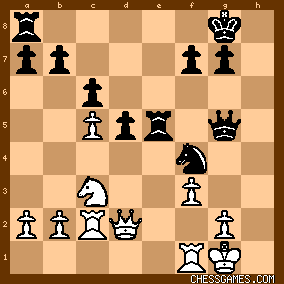
click for larger viewBlack to move and win.
As will be seen, this is a pretty stupid question, since just about anything remotely sensible wins for Black here: 28... Re2
This wins the White Queen and the game, but it is nowhere near the strongest and most brutal ways to wipe White off the board. Fritz and Stockfish play 28...Qg3!, which is sheer murder (e.g., 29. Rd1 Rae8 or 29. Qf2? Nh3+). 28...Rae8 immediately is also crushing. Halprin's move allowed Janowski to play on for a bit, but it did the trick: 29. QxR
There is nothing better.
29... NxQ+
30. RxN
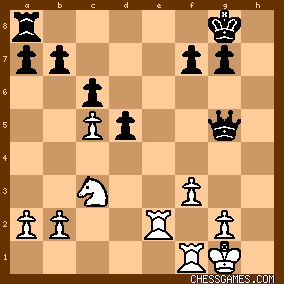
click for larger view30... Qf4
31. Rff2
Even here, Janowski played seemingly without thought. 31. Rfe1 or 31. Rd1 were the obvious options for one not inclined to thrown in the towel. 31... Qd4
Halprin could now choose how he wanted to win. He decided to grab ahd White pawn on c5. Other crushing moves were 31...Qc4; 311...d4; 31...f5; 31...g6, etc. 32. Re7
A worse than useless Rook expedition, as will be apparent from Janowski's next (even worse) move. 32... Qxc5

click for larger view33. Rxb7?
While it's always pleasant to grab a pawn, here it effectively cost Janowski a Rook, since after this capture the Rook had no way to get back into play and sat impotently on b7 for the remainder of the painful (for Janowski) struggle. 33... Re8!
Bringing his final piece into the fray. With one of his Rooks stranded on b7, Janowski was effectively playing with (pinned) Rook and Knight against Halprin's Queen, Rook (and two connected passed pawns): 
click for larger viewWhat followed was (predictably) a massacre which Janowski should have spared himself. |
|
Jun-02-19
 | | KEG: Post V
34. g3
Hoping to avoid losing a Rook to 34...Re1+. The text was probably the worst way to accomplish this, but it hardly mattered at this point. 34... Re1+
35. Kg2 d4

click for larger viewTime to throw in the towel? Uh-uh. Janowski wanted to get beaten to a pulp before he resigned. Halprin was willing to oblige him. 36. Ne4
Now the only question was how long it would take for Janowski to get mated. With 36. Ne2, Janowski would at least have delayed the entry of the Black Queen into the White camp. 36... Qc1

click for larger viewWho but Janowski would want to play this out?
37. g4 Rg1+
38. Kh2
Better than 38. Kh3 Qh6 mate, but not by much.
38... Rh1+
39. Kg3
Better than 39. Kg2 Qg1 mate.
39... g5
Was Halprin having too much sadistic fun to close out proceedings with 39...f5 or 39...Qh6? 40. Rd2
40. Rg2 was the only way to prolong the game.
40... Rg1+
Still having too much fun to terminate resistance with 40...Rf1 or 40...Re1 41. Kh2
41. Kh2 now leads to a quick mate for Black beginning with 41...Qe1+ 41... Qf1
"!"--(Tournament Book)
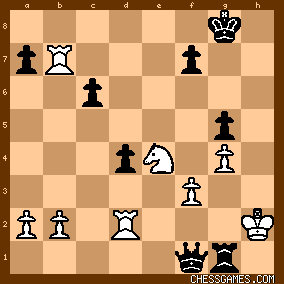
click for larger viewWhy the "!" ? This was far from the fastest way to win (e.g., 41...Re1; 41...Rf1, etc.). The text did, however, lead to a pretty finish (some reward for those of us who did not change channels long before). 42. Ng3 Qe1
43. Rg2 RxR+
44. KxR d3

click for larger viewHere, and not a moment too soon, Janowski decided to end his unhappy experience at Munich 1900 0-1 |
|
|
|
|





































